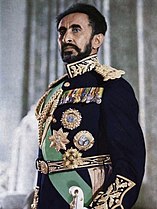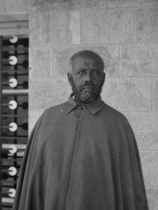
Second Italo-Ethiopian War
The Second Italo-Ethiopian War, also referred to as the Second Italo-Abyssinian War, was a war of aggression waged by Italy against Ethiopia, which lasted from October 1935 to February 1937. In Ethiopia it is often referred to simply as the Italian Invasion (Amharic: ጣልያን ወረራ, romanized: Ṭalyan warära), and in Italy as the Ethiopian War (Italian: Guerra d'Etiopia). It is seen as an example of the expansionist policy that characterized the Axis powers and the ineffectiveness of the League of Nations before the outbreak of the Second World War.
For other wars between Italy and Ethiopia, see Italo-Ethiopian war (disambiguation).
On 3 October 1935, two hundred thousand soldiers of the Italian Army commanded by Marshal Emilio De Bono attacked from Eritrea (then an Italian colonial possession) without prior declaration of war.[13] At the same time a minor force under General Rodolfo Graziani attacked from Italian Somalia. On 6 October, Adwa was conquered, a symbolic place for the Italian army because of the defeat at the Battle of Adwa by the Ethiopian army during the First Italo-Ethiopian War. On 15 October, Italian troops seized Aksum, and an obelisk adorning the city was torn from its site and sent to Rome to be placed symbolically in front of the building of the Ministry of Colonies.
Exasperated by De Bono's slow and cautious progress, Italian Prime Minister Benito Mussolini replaced him with General Pietro Badoglio. Ethiopian forces attacked the newly arrived invading army and launched a counterattack in December 1935, but their poorly armed forces could not resist for long against the modern weapons of the Italians. Even the communications service of the Ethiopian forces depended on foot messengers, as they did not have radio. It was enough for the Italians to impose a narrow fence on Ethiopian detachments to leave them unaware of the movements of their own army. Nazi Germany sent arms and munitions to Ethiopia because it was frustrated over Italian objections to its attempts to integrate Austria.[14] This prolonged the war and sapped Italian resources. It would soon lead to Italy's greater economic dependence on Germany and less interventionist policy on Austria, clearing the path for Adolf Hitler's Anschluss.[15]
The Ethiopian counteroffensive managed to stop the Italian advance for a few weeks, but the superiority of the Italians' weapons (particularly heavy artillery and airstrikes with bombs and chemical weapons) prevented the Ethiopians from taking advantage of their initial successes. The Italians resumed the offensive in early March. On 29 March 1936, Graziani bombed the city of Harar and two days later the Italians won a decisive victory in the Battle of Maychew, which nullified any possible organized resistance of the Ethiopians. Emperor Haile Selassie was forced to escape into exile on 2 May, and Badoglio's forces arrived in the capital Addis Ababa on 5 May. Italy announced the annexation of the territory of Ethiopia on 7 May and Italian King Victor Emmanuel III was proclaimed emperor on 9 May. The provinces of Eritrea, Italian Somaliland and Abyssinia (Ethiopia) were united to form the Italian province of East Africa. Fighting between Italian and Ethiopian troops persisted until 19 February 1937.[2] On the same day, an attempted assassination of Graziani led to the reprisal Yekatit 12 massacre in Addis Ababa, in which between 1,400 and 30,000 civilians were killed.[16][17][18] Italian forces continued to suppress rebel activity until 1939.[19]
Italian troops used mustard gas in aerial bombardments (in violation of the Geneva Protocol and Geneva Conventions) against combatants and civilians in an attempt to discourage the Ethiopian people from supporting the resistance.[20][21] Deliberate Italian attacks against ambulances and hospitals of the Red Cross were reported.[22] By all estimates, hundreds of thousands of Ethiopian civilians died as a result of the Italian invasion, which have been described by some historians as constituting genocide.[23] Crimes by Ethiopian troops included the use of dumdum bullets (in violation of the Hague Conventions), the killing of civilian workmen (including during the Gondrand massacre) and the mutilation of captured Eritrean Ascari and Italians (often with castration), beginning in the first weeks of war.[24][25]



